Publications
Latest Developments in the Canadian Economic Accounts
The 2006 to 2009 revisions of the Income and Expenditure Accounts
Archived Content
Information identified as archived is provided for reference, research or recordkeeping purposes. It is not subject to the Government of Canada Web Standards and has not been altered or updated since it was archived. Please "contact us" to request a format other than those available.
Introduction
Revised estimates of the Income and Expenditure Accounts (IEA) covering the period 2006 to 2009 have been released along with those for the first quarter of 2010. These revised estimates incorporate the most current source data and seasonal patterns.
Revision schedule
Statistical revisions are carried out regularly in the Canadian System of National Accounts (CSNA) in order to incorporate the most current information from censuses, annual surveys, administrative statistics, public accounts, etc. In principle, the revision schedule for the IEA is as follows: the first estimate for a given quarter is released approximately 60 days after the end of the reference quarter; this estimate is revised when estimates for subsequent quarters of the same calendar year are released; thereafter, the estimates are open for revision only once a year for the next four years, at the time of the release of the first-quarter estimates. For example, the estimates for the first quarter of 2006 were first released in May 2006. The first revision to these estimates occurred when the second-quarter estimates were released, in August 2006; further revisions were carried out when the estimates for the third and fourth quarters of 2006 were released. These IEA estimates were revised again in each of the next three years (2007, 2008, and 2009), with the last of these revisions occurring with this release.
The policy of revising the estimates of previous years only once a year is adhered to throughout the CSNA. The period open for revision, however, varies from one set of accounts to the other. Thus, the standard revision is four years with respect to the Income and Expenditure Accounts and the Balance of International Payments. The standard revision in the Input-Output Tables covers one year—the first year of the four years of revision of the Income and Expenditure Accounts and of the Balance of Payments statistics. The revision of the Financial Flow Accounts usually parallels that of the National Balance Sheet Accounts and may occasionally cover more than four years in order to allow for harmonizing the flows with the revised stocks.
The annual revision process is integrated within the CSNA, with revised estimates of the National Income and Expenditure Accounts, Financial Flow Accounts, and the Balance of International Payments, compiled and released together. For example, updated estimates of detailed financial transactions underlying gross domestic product (GDP) are harmonized with revised estimates of sector incomes and outlays. Revised estimates of the National Balance Sheet Accounts are released about two weeks later; these are based largely on the updated sources of financial and capital transactions as well as on estimates of capital gains or losses implicit in the stock estimates.
The integration of GDP estimates by component occurs through compiling Input-Output Tables in current prices for the first two years of the four-year revision period. These data are released in the fall of each year when the full provincial Input-Output Tables are completed. Corresponding revisions to the monthly estimates of real GDP by industry are released in September. Industry-based estimates are integrated annually, at the time of the first quarter, with the income- and expenditure-based measures of GDP. Revisions to the last two years of the four-year revision cycle arise as a result of incorporating new or revised sub-annual and annual sources of information.
Following this release, the Income and Expenditure Accounts will move towards a three-year revision cycle. Over the last number of years, Statistics Canada has been able to increase the overall timeliness of its annual business and institutional surveys, and of its administrative-data processing. Consequently, the majority of 'final' data are now incorporated into the first release of the national Input-Output Tables, which serve as the benchmark for the Income and Expenditure Accounts. Given that little new information is available with the second release of the Input-Output Tables, Statistics Canada will produce only one vintage of the national, provincial and territorial Input-Output Tables.
Limited revisions are sometimes carried out with respect to periods further back than four years, and historical revisions are conducted periodically, roughly once every 10 to 15 years. Historical revisions provide an opportunity to improve estimation methods and to introduce conceptual changes into the CSNA. The most recent historical revision was completed in December 1997. Documentation related to this revision can be found at Historical Revision of the National Economic and Financial Accounts. The next historically revised data are scheduled to be released in 2012. For more information on the change to the revision cycle and on the CSNA historical revision, please consult Renewing the Canadian System of National Accounts.
Impact of the revisions on gross domestic product (GDP)
The current revisions to GDP reflect the most current estimates from data sources, including survey results, administrative data, and public accounts. Revised 2006 and final 2007 Input-Output data are incorporated for the first two years of the four-year revision period. New benchmark information is incorporated for the more recent periods. Other series are revised as a result of applying existing or updated projectors to the new levels received from the Input-Output Tables. Additional conceptual or classification changes are sometimes implemented within the National Income and Expenditure Accounts. Documentation related to these conceptual changes can be found at Latest Developments in the Canadian Economic Accounts. No conceptual changes have been made to the Income and Expenditure Accounts this year.
Table 1 Selected components, current revision
Revisions to GDP
The real GDP annual growth rate was revised in each of the four years covered by the current revision cycle. The annual growth in real GDP was revised downward in both 2006 and 2007 and upward in both 2008 and 2009. The trend in the annual growth rate of GDP remained the same: there was a gradual decline from 2006 to 2007, a more substantial decline in 2008 and a contraction in 2009.
Chart 1 Revisions to real
GDP by year (current and previous)
Description for Chart 1
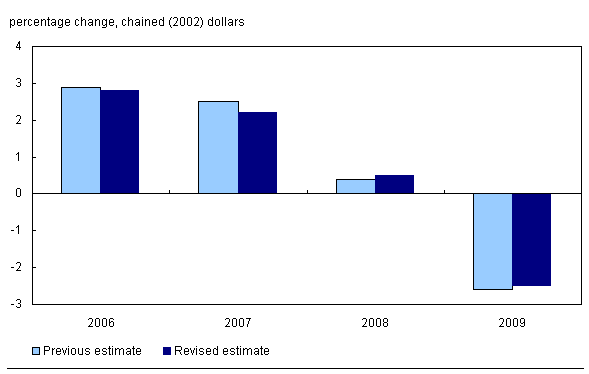
Revisions to GDP for reference year 2006
The level of nominal GDP was revised upward by $1.2 billion in 2006 Estimates of operating surplus, personal expenditure on durable goods and government current expenditures originating from the 2006 Input-Output Tables were all revised. These revised estimates have been incorporated into the Income and Expenditure Accounts.
The cumulative1 revision to the nominal level of GDP for 2006 was $11.1 billion, and the cumulative revision to the nominal growth rate was 0.7 percentage points. These figures are high in comparison to recent cumulative revisions to GDP. The cumulative mean absolute revision to the level of GDP for the period 2002 to 2005 was $4.9 billion, and the cumulative mean absolute revision to the growth in GDP was 0.3 percentage points.
The nominal GDP growth rate for 2006 has been revised to 5.6%, from the previous estimate of 5.5%. Conversely, the real GDP growth rate has been revised downward by 0.1 percentage points, from 2.9% to 2.8%, owing in part to an updated methodology used to estimate import and export services prices, which revised the GDP deflator upward.
The total cumulative revision to the real GDP annual growth rate for 2006 was substantially lower than the cumulative revision to the nominal GDP annual growth rate noted above. The cumulative revision to real GDP was 0.1 percentage points; this figure is well within the historical norm.
Since 2002, the mean absolute revision to nominal GDP resulting from the incorporation of the final Input-Output Tables has been 0.1 percentage points. In comparison, for the period 1997 to 2001, the mean absolute revision from the incorporation of the final Input-Output benchmarks was 0.2 percentage points.
Between 1997 and 2001, Statistics Canada invested heavily in its annual business survey program. As these new estimates were incorporated into the CSNA, the data were subject to larger revisions. The statistical system has become more stable in recent years, and the timeliness of these data has improved. This explains, to a significant extent, the lower revisions now being observed following the incorporation of the final Input-Output benchmarks. This is also a determining factor in the decision to move toward a three-year revision cycle as noted above.
On a quarterly basis, real GDP in 2006 was revised upward by 0.1 percentage points in the first quarter, downward by 0.2 percentage points in the second quarter, was unchanged in the third quarter and revised upward by 0.1 percentage point in the fourth quarter.
Chart 2: Revisions to real GDP for 2006 by quarter (current and previous)
Description for Chart 2
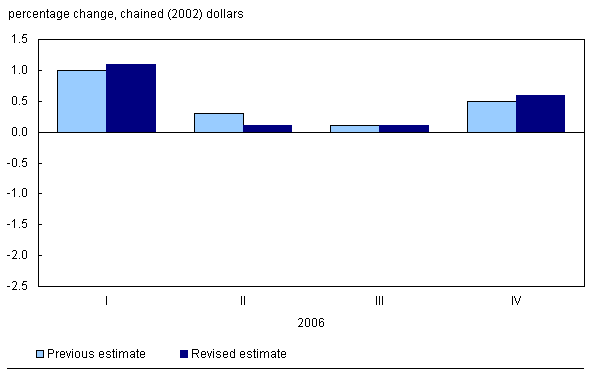
Revisions to GDP for reference year 2007
The $3.4 billion downward revision of the nominal GDP in 2007 is driven mainly by lower levels of surplus and lower non-farm business inventories than had been previously estimated. These revisions are partially offset by upward revisions to personal expenditure on goods and services.
Table 2 provides a history of the revisions to GDP for the period 1996 to 2009. As noted earlier, each annual estimate is the subject of four different annual revision cycles as well as periodic historical revision processes. This table provides the published level and growth rate of GDP for a given year with respect to each of these revision cycles. The largest revisions to GDP normally occur with the second and third revision cycles, in which the Income and Expenditure Accounts are benchmarked to the T4 (Statement of Remuneration Paid) administrative data (second revision cycle), estimates derived from the Public and Private Investment Survey (second revision cycle), and the preliminary Input-Output Tables (third revision cycle).
The $3.4 billion revision for 2007 was larger than the recent historical average. Between 2002 and 2006, the mean absolute revision resulting from the incorporation of the preliminary Input-Output benchmarks was $2.1 billion.
The cumulative revision to both the nominal growth rate (-0.4 percentage points) and the real growth rate (-0.5 percentage points) for 2007 are substantial. Over half of this cumulative revision is attributable to the most recent revision cycle in which the Income and Expenditure Accounts were benchmarked to the 2007 Input-Output tables.
Table 4 shows the revisions to the growth in nominal and real GDP. Nominal and real GDP for 2007 were both revised downward by 0.3 percentage points. This is the most significant revision to GDP registered during this revision cycle and is high by historical standards.
Quarterly real GDP in 2007 was revised downward by 0.3 percentage points in the first quarter, 0.2 percentage points in the second quarter and revised upward by 0.1 percentage points in the third quarter and 0.2 percentage points in the fourth quarter. These revisions altered the quarterly trend in 2007 from one of a fairly sharp deceleration in the growth of real GDP over the year to a more gradual deceleration in growth.
Chart 3 Revisions to real GDP for 2007 by quarter (current and previous)
Description for Chart 3
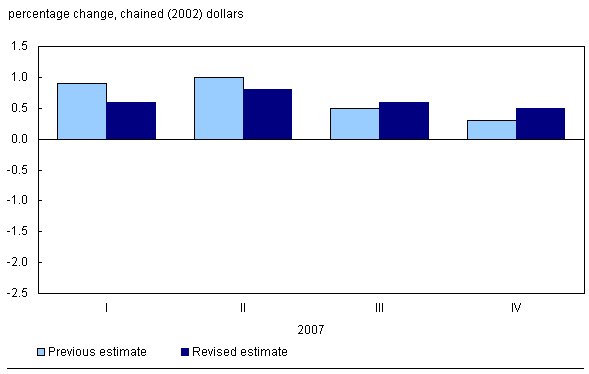
Revisions to GDP for reference year 2008
The level of nominal GDP in 2008 was revised downward (-$0.5 billion). While the revision to the level of GDP was small, there were significant revisions to various components of GDP.
The estimates for reference year 2008 represent the second time that the 2008 data have gone through the annual revision cycle. Revisions to various components of GDP can be significant at this time as a number of benchmark series are introduced into the Income and Expenditure Accounts. Employment income data (T4 records) from the Canada Revenue Agency and updated pension information from the Census of Pension Plans in Canada are used to revise estimates of labour income. Revised data from the Capital Expenditures Survey are used to update estimates of business and government gross fixed capital formation. Estimates from a number of annual business surveys are used to update components such as personal expenditure on goods and services and business investment in inventories.
The overall 2008 revision to the level of GDP is small in comparison to historical standards. The mean absolute revision to the level of nominal GDP from 2002 to 20072 between the first revision cycle and the second revision cycle was $2.8 billion. This is significantly higher than the $0.5 billion registered for 2008 during this revision cycle.
Even though the level of GDP did not change significantly, the growth in nominal GDP was revised upward by 0.2 percentage points. Many of the downward revisions to the level of GDP in 2007 were not observed when the new and revised source data were incorporated 2008; this resulted in the upward revision to the 2008 growth rate.
The growth in real GDP was similarly revised upward, by 0.1 percentage points, in line with the nominal growth rate. On a quarterly basis, the trend in real GDP remained the same, with a decline in GDP in the first quarter, little change in the second and third quarter and a substantial decline in the fourth quarter.
Chart 4 Revisions to real GDP for 2008 by quarter (current and previous)
Description for Chart 4
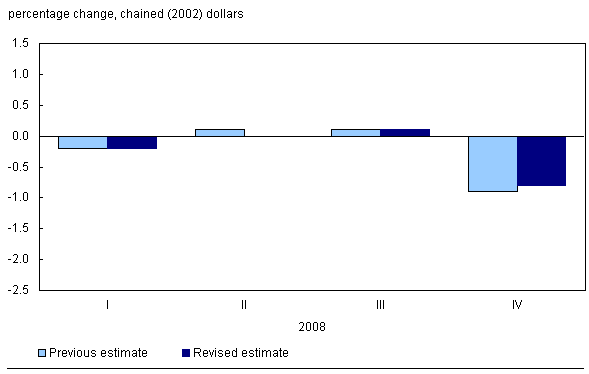
Revisions to GDP for reference year 2009
The level of GDP was revised downward by $0.4 billion in 2009. The downward revisions to labour income and to net income of unincorporated businesses in 2008 were carried forward to 2009. These downward revisions were offset by upward revisions to surplus, government current expenditure on goods and services and personal expenditure on goods and services.
The growth in nominal GDP was unchanged in 2009 from the previously published estimates. In four out of the last eight years there has been no revision to the growth in GDP resulting from the data passing through the first revision cycle. In general, revisions to estimates carried out during the first revision cycle are not significant. While changes in the level of GDP can be significant, the revision to the growth in GDP does not tend to be as substantial since little new information is available.
The quarterly pattern remained similar to previously published estimates: substantial declines in GDP took place in the first two quarters of the year; a slight increase was registered in the third quarter; and strong growth was noted in the final quarter.
Chart 5: Revisions to real GDP for 2009 by quarter (current and previous)
Description for Chart 5
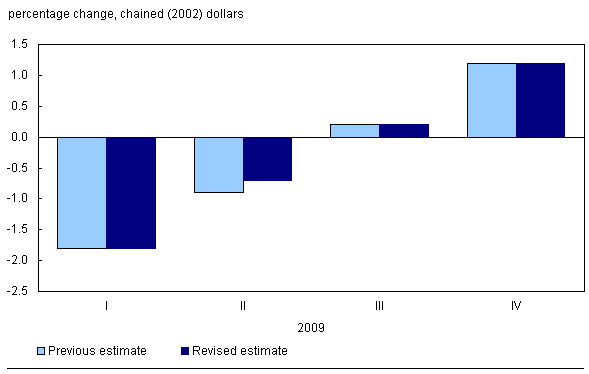
Revisions to income aggregates
Estimates of wages, salaries, and supplementary labour income are revised downward by $4.5 billion in 2008 and 2009. Estimates are unchanged for 2006 and 2007. Revisions in 2008 reflect data from the T4 administrative data file as well as from other benchmark sources. In 2008, the majority of the $4.5-billion change stems from downwardly revised estimates of wages and salaries in service industries. The growth rate for wages, salaries, and supplementary labour income for 2008 was revised downward from 4.9% to 4.3%. This downward revision for 2008 is carried forward to 2009, leaving the 2009 growth rate unchanged.
Within the CSNA, surplus is defined as the income that corporations obtain from their own production activities—value added at basic prices, less compensation paid to employees, less taxes payable on production, plus subsidies received. It represents the last balancing item in the Input-Output Tables and is calculated for each industry. As part of the annual benchmarking to the Input-Output Tables, estimates of surplus are generated by incorporating data from the latest annual business and institutional surveys as well as various administrative data into the Input-Output framework. Once these benchmark estimates of surplus are derived, the revisions are incorporated into the Income and Expenditure Accounts. In the Income and Expenditure Accounts, surplus includes the following income components: corporation profits before taxes; interest and miscellaneous investment income; government business enterprise profits before taxes, inventory valuation adjustment; and capital consumption allowances.
Surplus is revised upward by $0.8 billion for 2006 and downward by $3.5 billion for 2007. It is higher by $6.2 billion in 2008 and by $2.9 billion in 2009. The revisions in 2006 and 2007 are mostly a reflection of revised estimates in the mining and manufacturing industries originating in the Input-Output Tables. Table 1 shows the revisions to surplus for the period 2006 to 2009 as well as the distribution of the revision among its various income components.
Estimates of corporation profits before taxes are revised upward in 2006, downward in 2007 and upward in 2008 and 2009. The revisions are average by historical standards: the mean absolute revision for this revision cycle rests at about $2.1 billion. New estimates from the preliminary Financial and Taxation Statistics for Enterprises, including the General Index of Financial Information (GIFI) schedules and other annual sources, have been incorporated for 2008. The 2009 estimates are based on revised estimates from the Quarterly Financial Statistics for Enterprises.
Government business enterprise profits were revised in each of the four years of the revision cycle. The largest revision was that for 2008, when the estimates were revised upward by $0.8 billion. The revisions reflect new data originating from the income statements and balance sheets of government business enterprises.
Interest and miscellaneous investment income were revised downward in 2006 and 2007, upward in 2008, and downward in 2009. A substantial portion of the revisions for 2008 and 2009 results from a re-profiling of government royalty revenue. Government royalty revenue is recorded in the National Accounts on an accrual basis. The revised estimates better reflect the period in which the royalties were earned rather than when they were received.
Capital consumption allowances were virtually unchanged in 2006 and were revised upward in 2007, 2008, and 2009. The substantial upward revisions carried out in 2008 and 2009 originate from revised estimates of government non-financial assets introduced into the National Balance Sheet last year. These have translated into higher levels of government capital consumption allowances in the current revision cycle. Updated annual corporate income tax returns, together with additional depreciation estimates from the Investment and Capital Stock Division's perpetual inventory model, where also a source of these revisions.
There were minimal revisions to the inventory valuation adjustment in 2006 (-$29.0 million), downward revisions in 2007 (-$498.0 million), 2008 ($-129.0 million), and 2009 (-$445.0 million).
The accrued net income of farm operators from farm production is virtually unchanged in 2006 and 2007; more substantial upward revisions were made for 2008 and 2009. Revisions originate from the incorporation of revised estimates of farm cash receipts obtained from various Statistics Canada agriculture surveys as well as the incorporation of administrative data from Agriculture and Agri-Food Canada, the Canadian Wheat Board, and other marketing and regulatory boards. Revisions to farm operating expenses reflect the incorporation of the latest estimates from the Taxation Data Program.
Net income of non-farm unincorporated business was revised downward in 2008 and 2009. The downward revisions stem from the incorporation of estimates derived from the T1 (Individual Tax Return) administrative data files.
Preliminary quarterly estimates of net income of non-farm unincorporated business are derived by means of a variety of indicators, such as the growth in personal expenditure on goods and services, the growth in GDP by industry, and the growth in wages and salaries by industry. These indicators tended to overstate net income of non-farm unincorporated businesses in 2008 and 2009. In addition, over the last number of years, a number of unincorporated businesses in the law, medical, and accounting industries have incorporated. The result is that this activity is shifting from the persons and unincorporated businesses sector to the corporate sector. The quarterly estimation system has had difficulty in measuring this structural shift which only became evident when the T1 administrative data was examined.
The estimate of taxes on factors of production less subsidies is revised upward in 2008 and 2009. Taxes on products less subsidies are revised upward in 2006 through 2009. Revisions to both taxes and subsidies reflect new public accounts and other financial information for the different government sub-sectors.
Revisions to expenditure aggregates at current prices
Table 6 Revisions to expenditure aggregates at current prices
Estimates of personal expenditure on consumer goods and services are revised upward by $0.5 billion in 2006, $0.7 billion in 2007, downward by $0.9 billion in 2008, and upward by $2.0 billion in 2009. The revisions for 2006 and 2007 originate from the Input-Output Tables. The revisions to 2008 reflect the revised Quarterly Retail Commodity Survey, the Annual Retail Trade Survey, the Annual Survey of Service Industries, as well as Goods and Services Tax and other administrative data files.
The revised estimates of new and used (net) motor vehicles is the main contributor to the upward revision to personal expenditure on consumer goods and services throughout the four year revision cycle.
The large upward revision in the 2009 household purchases of motor vehicles and trucks is a result of a re-allocation of purchases of new motor vehicles from the business sector to the household sector. The original estimate of business investment in automobiles and trucks was lowered; the purchases are now shown as having been made by the household sector and are therefore included in personal expenditure on consumer goods. The changes to the government current expenditure on goods and services estimates are as follows: $0.5 billion in 2006; $-1.2 billion in 2007; $0.7 billion in 2008; and $2.1 billion in 2009.
These revisions reflect new data from the federal government accounting system and provincial public accounts, as well as the latest local government information. Survey results for 2007 from the Canadian Institute for Health Information (CIHI) and the Culture, Tourism and the Centre for Education Statistics – Research Papers are also incorporated and carried forward to 2009. Current expenditure by provincial and local governments was revised upward in 2008 and 2009, while spending by the federal government was revised downward.
Estimates of government gross fixed capital formation are revised upward in 2006 and 2007; this was followed by a substantial downward revision in 2008 (-$2.4 billion) and in 2009 (-$1.5 billion). These revisions changed the trend in government investment between 2007 and 2009. The original trend showed investment growing roughly 20% in from 2007 to 2008 and another 18% from 2008 to 2009. The revised estimates now show government investment growing 12% in 2008 and 16% in 2009.
There was no revision to government investment in inventory.
Business gross fixed capital formation registered only small revisions for 2006 and 2007. The revision for 2008 was large by historic standards and has also resulted in a large change in the mix of investment estimated for 2008. Investment in non-residential structures was revised upward by $7.2 billion. Some of this amount was offset by a downward revision in business investment in machinery and equipment ($-1.9 billion) as well as a downward revision in government gross fixed capital formation. The growth rate in investment in non-residential structures for 2008 was revised upward by 8.0 percentage points.
Business investment in residential construction, mainly estimates of alterations and improvements and of ownership transfer costs, was also revised downward in 2008 and 2009. These data now incorporate the latest information from the Survey of Household Spending and the Annual Survey of Service Industries: Real Estate agents, brokers, appraisers and other related activities. For the most part, the revisions from 2008 were carried forward to 2009.
Business investment in machinery and equipment in 2009 was revised downward by $3.0 billion. As noted above, the reallocation of the purchases of new motor vehicles to the household sector accounts for a large portion of this figure. As well, a substantial downward revision to the estimate of investment in telecommunication equipment originating from the 2007 Input-Output Tables was carried forward to 2008 and 2009. Overall, business investment in plant and equipment was revised downward by $1.0 billion in 2009.
A large part of the revisions to government and business gross fixed capital formation in 2008 and 2009 follows from the incorporation of estimates from the Capital Expenditures Survey. The 2008 income and expenditure accounts now incorporate the revised 2008 investment data from the Private and Public Investment Survey, while the 2009 income and expenditure accounts now closely align with the preliminary estimates of private and public investment for 2009.
Revisions to non-farm business investment in inventories are based on new information from the latest annual surveys. The downward revisions to 2006 and 2007 reflect the results of the commodity balancing process that is integral to the compilation of the Input-Output Accounts, to which the Income and Expenditure Accounts are benchmarked. The downward revision in 2008 reflects the incorporation of the latest annual manufacturing, wholesale, and retail industry surveys. The majority of the revisions in 2006, 2007, and 2008 occurred in the wholesale and retail industries.
Exports in current dollars are revised downward in 2006 and upward in 2007, 2008 and 2009. Revisions to exports of goods are minimal while the revisions to exports of services are more substantial in 2008 and 2009. Exports of services were revised upward by $1.6 billion in 2008 and by $0.5 billion in 2009. These upward revisions result almost entirely from revised estimates of exports of commercial services.
Imports in current dollars record a slight downward revision in 2006 and upward revisions in 2007 through 2009. Imports of goods and services such as energy products, industrial goods and materials, transportation services, and commercial services were all revised over the revision period.
Data Tables
- Table 1 Selected components, current revision
- Table 2 Revisions to gross domestic product, historical perspective
- Table 3 Revisions to gross domestic product
- Table 4 Revisions to gross domestic product (growth rates)
- Table 5 Revisions to income aggregates
- Table 6 Revisions to expenditure aggregates
Notes
- The cumulative revision represents the difference in the level of GDP between the initial estimate and the final estimate.
- The year 2001 is excluded from this analysis since a major conceptual changes was made to the CSNA in 2001 which saw the incorporation of the capitalization of software into the System of National Accounts. This served to increase the level of GDP.
- Date modified:
